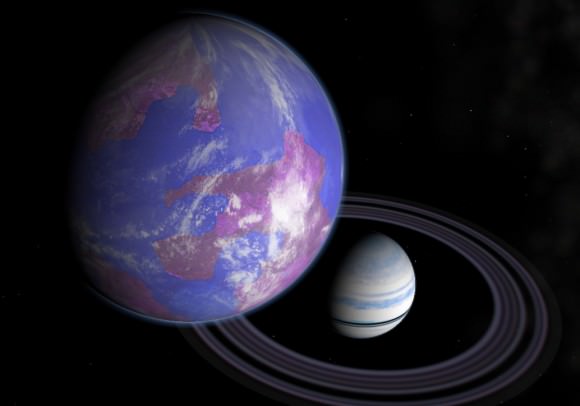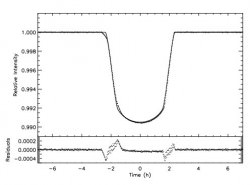
An artist impression of an exomoon orbiting an exoplanet, could the exoplanet's wobble help astronomers? (Andy McLatchie)
In an article earlier this month, I discussed the potential for discovering moons orbiting extrasolar planets. I’d used an image of an exoplant system with rings, prompting one reader to ask if those would be possible to detect. Apparently he wasn’t the only person wondering.A new paper looks more at exomoons and explores exoring systems.
The idea of detecting rings around distant planets dates back to at least 2004. Then, Barnes & Fortney suggested that rings would be potentially detectable from the eclipse they would cause if the photometric precision were as one part in ten-thousand. This is a big challenge, but one that’s more than met by telescopes like Kepler today. But for this to be possible, the rings needed to block the most light possible, meaning that they would have to be viewed face on, instead of edge on.
Fortunately, a study this year by Schlichting & Chang demonstrated that, even if the planet’s spin is aligned with the plane of orbit, it’s quite possible that the rings will be significantly warped due to gravitational interactions with the star.
So it should be possible, but what do astronomers need to look for?
The new paper attempts to answer this question by simulating light curves for a hypothetical ringed exoplanet. The first result is that the extra area of the star’s surface covered by the rings reduces the light detected. However, this is difficult to disentangle from the effects of simply having a larger planet that blocks the light.

Simulated light curve for exoplanet system with rings vs model lacking rings. Credit: Tusnski & Valio
A second effect is based on the shape of the light curve (a graph of the brightness as a function of time) as the planet begins and ends the transit. In short, the semi-transparent nature of the rings makes the drop in brightness softer, rounding off the edges of the light curve. When modeled against a planet that lacked rings, this would be readily detectable for an instrument likeKepler.
With such precision, the team suggests thatKepler should be more than capable of detecting a ring system similar in size and nature to those of Saturn. However, other transit finding telescopes, such as CoRoT, would mistake the rings for a slightly larger planet.
In the future, the team plans to take their model and reexamine data from Kepler and CoRoT to search for both rings and moons.
Source: Universe Today
No hay comentarios:
Publicar un comentario